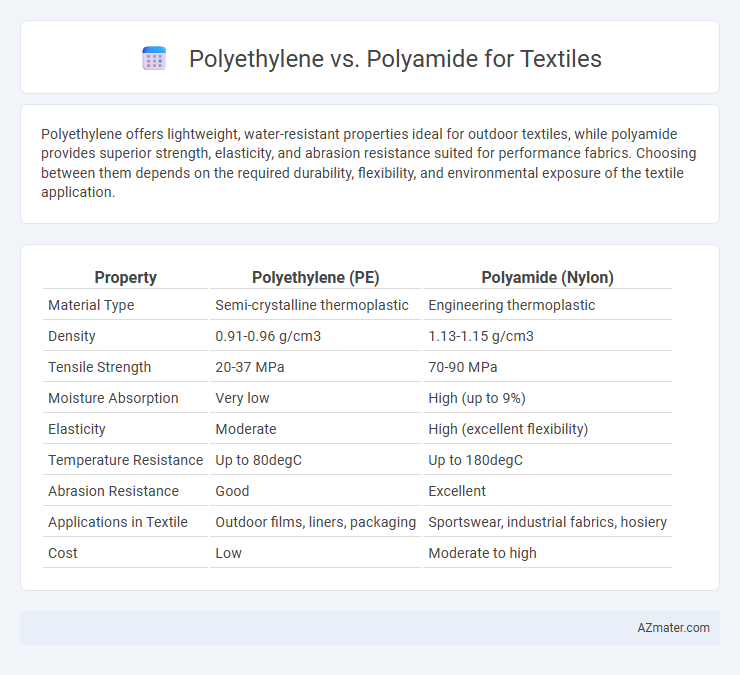Polyethylene offers lightweight, water-resistant properties ideal for outdoor textiles, while polyamide provides superior strength, elasticity, and abrasion resistance suited for performance fabrics. Choosing between them depends on the required durability, flexibility, and environmental exposure of the textile application.
Table of Comparison
| Property | Polyethylene (PE) | Polyamide (Nylon) |
|---|---|---|
| Material Type | Semi-crystalline thermoplastic | Engineering thermoplastic |
| Density | 0.91-0.96 g/cm3 | 1.13-1.15 g/cm3 |
| Tensile Strength | 20-37 MPa | 70-90 MPa |
| Moisture Absorption | Very low | High (up to 9%) |
| Elasticity | Moderate | High (excellent flexibility) |
| Temperature Resistance | Up to 80degC | Up to 180degC |
| Abrasion Resistance | Good | Excellent |
| Applications in Textile | Outdoor films, liners, packaging | Sportswear, industrial fabrics, hosiery |
| Cost | Low | Moderate to high |
Introduction to Polyethylene and Polyamide in Textiles
Polyethylene in textiles is valued for its lightweight, moisture-resistant properties, making it ideal for sportswear and outdoor fabrics. Polyamide, commonly known as nylon, offers high strength, elasticity, and abrasion resistance, suitable for performance apparel and industrial textiles. Both polymers serve distinct roles in textile manufacturing due to their unique chemical structures and functional characteristics.
Chemical Structure and Composition
Polyethylene consists of long chains of ethylene monomers, characterized by a simple hydrocarbon backbone with only carbon and hydrogen atoms, resulting in a non-polar, hydrophobic polymer with excellent chemical resistance. Polyamide, commonly known as nylon, contains repeating amide groups (-CONH-) within its molecular chain, which introduce polar sites capable of hydrogen bonding, enhancing moisture absorption and mechanical strength. The chemical structure differences between polyethylene's non-polar chains and polyamide's polar amide linkages significantly influence their textile performance, with polyethylene offering chemical inertness and polyamide providing greater durability and elasticity.
Manufacturing Processes
Polyethylene fibers are produced primarily through melt spinning, which offers high speed and cost efficiency due to the polymer's low melting point and viscosity. Polyamide fibers, conversely, require more complex processes such as solution spinning or melt spinning with precise temperature control to handle their higher melting points and to maintain molecular alignment. The manufacturing of polyamide textiles involves additional steps like drawing and heat setting to enhance strength and elasticity, making it more energy-intensive compared to polyethylene production.
Mechanical Properties Comparison
Polyamide fibers exhibit superior tensile strength and elasticity compared to polyethylene, making them ideal for high-performance textile applications requiring durability and flexibility. Polyethylene, particularly ultra-high-molecular-weight polyethylene (UHMWPE), offers exceptional impact resistance and low density, contributing to lightweight yet strong fabrics. Mechanical properties such as abrasion resistance and fatigue durability are generally higher in polyamide textiles, while polyethylene provides better resistance to chemicals and moisture absorption.
Moisture Absorption and Breathability
Polyamide fibers exhibit higher moisture absorption and superior breathability compared to polyethylene, making them more suitable for activewear and performance textiles. Polyethylene is hydrophobic with low moisture regain, resulting in limited breathability but excellent water resistance and quick drying properties. Textile applications prioritize polyamide for comfort in humid conditions, while polyethylene is favored for moisture-wicking and durability in water-resistant fabrics.
Durability and Wear Resistance
Polyamide, commonly known as nylon, offers superior durability and wear resistance compared to polyethylene in textile applications due to its high tensile strength and resistance to abrasion. Polyethylene fibers, especially ultra-high-molecular-weight polyethylene (UHMWPE), exhibit excellent wear resistance and impact strength but typically lack the UV stability and heat resistance of polyamide. For long-lasting textiles subjected to heavy abrasion and mechanical stress, polyamide remains the preferred material, while polyethylene is favored for lightweight, cut-resistant fabrics requiring high impact performance.
Dyeability and Color Retention
Polyamide fibers exhibit superior dyeability compared to polyethylene due to their polar amide groups, which readily bond with a wide range of dyes, resulting in vibrant and rich colors. Polyethylene's hydrophobic nature limits dye absorption, leading to lower color intensity and poor retention after washing or exposure to sunlight. Consequently, polyamide textiles maintain color durability and resistance to fading better than polyethylene materials in textile applications.
Environmental Impact and Sustainability
Polyethylene fibers exhibit lower environmental impact due to their simpler polymer structure, resulting in easier recyclability and reduced energy consumption during production compared to polyamide. Polyamide, often derived from petroleum-based sources, involves more intensive manufacturing processes and generates higher greenhouse gas emissions, impacting sustainability negatively. Biodegradability remains limited for both, but innovations in bio-based polyamides offer improved eco-friendliness, positioning polyethylene as a preferable option for minimizing textile industry carbon footprints.
Common Applications in the Textile Industry
Polyethylene is widely used in textiles for producing lightweight, water-resistant fabrics such as outdoor apparel, industrial covers, and geotextiles due to its excellent moisture barrier and durability. Polyamide, commonly known as nylon, is favored for high-performance textiles including activewear, hosiery, and upholstery because of its superior strength, elasticity, and abrasion resistance. Both polymers serve distinct roles in the textile industry, with polyethylene excelling in protective and industrial applications, while polyamide dominates in fashion and technical performance wear.
Cost-Effectiveness and Market Trends
Polyethylene fibers offer cost-effective advantages in textile production due to their lower raw material costs and simpler manufacturing processes compared to polyamide, driving their increased use in budget-friendly applications such as packaging and geotextiles. Polyamide, known for superior durability and elasticity, commands higher prices, appealing to performance-driven textile markets like sportswear and industrial fabrics. Market trends indicate growing demand for sustainable polyethylene variants, while polyamide faces competition from bio-based alternatives, influencing pricing and material selection strategies.

Infographic: Polyethylene vs Polyamide for Textile
 azmater.com
azmater.com